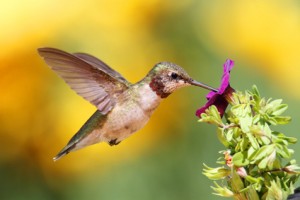 With wings that beat up to 200 times per second and the ability to hover straight up and down, sideways, backwards, and even upside down, hummingbirds need a lot of energy.
With wings that beat up to 200 times per second and the ability to hover straight up and down, sideways, backwards, and even upside down, hummingbirds need a lot of energy.
Although hummingbirds will eat insects, most of that energy comes from the nectar of flowers, and you can invite these guests to dine in your garden by planting known hummingbird plants.
Hummingbirds Everywhere
There are 320 hummingbird species in North, Central, and South America, so chances are you will find at least a species or two that call your region of the country home. Many of the hummingbirds found in the United States migrate and overwinter in Mexico, returning to northern climates in spring, and moving to higher elevations as wildflowers start to bloom.
Seeing Red – Hummingbird Plants
One of the best ways to attract hummingbirds is to grow known hummingbird plants in your garden. You’re not just limited to summer flowers. There are many trees, shrubs, vines, and perennial flowers that attract hummingbirds. They bloom during different months and can extend the seasons in which you will see hummingbirds in your garden. To attract your native hummingbirds, plant some native plants in your garden. These hummingbird plants will be especially adapted to the hummingbirds in your areas as they have evolved in association with one another.
The plants most known as hummingbird plants are those with nectar-rich, red, orange, or red-orange tubular flowers. There are other flowers that attract hummingbirds, but flowers that are the brightest red are the most effective at capturing their attention. Old-fashioned, single-flowered blossoms, as opposed to double-flowered hybrids, are the best at attracting hummingbirds. The reason for this is that older plant species typically have more nectar, and it is easier for the hummingbirds to access than in double-flowered plant varieties. A few good hummingbird plants to consider adding to your garden are Fuschia magellanica (hardy fuschia), Monarda didyma (bee balm), and Aquilegia canadensis (red columbine).
Plan an Escape Route
When hummingbirds are feeding, they are vulnerable to attack from neighborhood cats and other predators like crows and jays. While feeding, a hummingbird’s head can be deep inside a flower, and it may not see a predator approaching. For this reason, it is important to provide a variety of plantings that can serve as a means of escape. A good way to offer protection against cats, for example, is to grow hummingbird plants that are at least 2 feet tall. Hanging pots of fuschias, geraniums, and red impatiens will also attract hummingbirds and allow them to feed safely.
Provide a Source of Water
Hummingbirds are attracted to birdbaths, but they are particularly attracted to the sound of running water. Fountains or any device that provides a spray or fine mist is best.
A List of Hummingbird Plants
This list is not comprehensive but should provide plenty of variety for your garden.
Abelia grandiflora (Glossy abelia)
Antirrhinum spp. (Snapdragon)
Aquilegia formosa (Columbine)
Arbutus unedo (Strawberry tree)
Canna spp. (Canna)
Chaenomeles japonica (Flowering quince)
Cleome spinosa (Spider flower)
Dahlia merkii (Dahlia)
Delphinium (Delphinium)
Digitalis spp. (Foxglove)
Fuschia magellanica (Hardy fuschia)
Gladiolus spp. (Gladiolus)
Heuchera spp. (Coral bells)
Hibiscus syriacus (Rose of Sharon)
Iris spp. (Iris)
Kalmia polifolia (Bog laurel)
Kniphofia uvaria (Red hot poker plant)
Lavandula spp. (Lavender)
Lilium spp. (Lily)
Lobelia cardinalis (Cardinal flower)
Lonicera spp. (Honeysuckle)
Monarda didyma (Bee balm)
Nicotiana spp. (Flowering tobacco)
Pelargonium hybrids (Geranium)
Penstemon spp. (Penstemon)
Phaseolus spp. (Scarlet runner beans)
Rhamnus purshiana (Cascara)
Ribes sanguineum (Red-flowering currant)
Sambucus spp. (Elderberry)
Scabiosa spp. (Scabiosa)
Syringa spp. (Lilac)
Tropaeolum majus (Nasturtium)
Weigela florida (Weigela)
